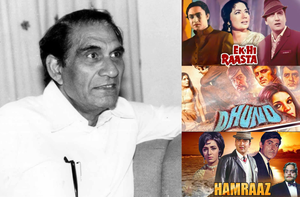New Delhi: A unique combination of circumstances led to him landing in Bombay soon after the Partition and being tasked with directing a film, though his cinematic experience was limited to being a film journalist. He even managed to rope in a top actor – and on the very first day, questioned his rendition of a crucial scene.
Recalling the episode decades later, veteran Hindi film director and producer B.R. Chopra revealed that Ashok Kumar, who had somehow agreed to act in the film despite his misgivings at its totally green director, was taken aback.
“He then suggested that he would do the shot again in the way I suggested, and prints of both this and the way he had done, should be made, and he would check them the next day to see which was better,” he told Bollywood personality and chronicler Shashi Ranjan in an interview.
As a nervous Chopra arrived at the studio quite early the next day, his tension increased as the star had reached even earlier and was waiting for him, especially when he got a gruff “Come in” as he knocked on his door. A brief, uncomfortable silence followed before Ashok Kumar had just one question – what was his name?
His response didn’t please the star, who somewhat irritatedly said that he was sure his parents didn’t call him B.R. Chopra. As Chopra said his given name was Baldev, Ashok Kumar said that from now onward, he would use the same name as he was impressed to find a rookie director’s conception of the scene was better than his.
It was a moment of validation for B.R. Chopra, born on this day (April 22) in the Jalandhar district of undivided Punjab in 1914, and made sweeter for the unsuccessful ICS aspirant-turned-film journalist as the film “Afsana” (1951) became a commercial and critical success.
The same status was enjoyed by the next five films he helmed – ‘Shole’ (1953), ‘Chandni Chowk’ (1954), ‘Ek Hi Raasta’ (1956) – the first film of his banner, the evergreen ‘Naya Daur’ (1957), and ‘Sadhana’ (1958). For ‘Dhool ka Phool’ (1959), B.R. Chopra entrusted the director’s hat to his younger brother and assistant Yash Chopra, and they alternated as directors throughout the 1960s until the latter separated professionally in 1970.
However, B.R. Chopra continued to post hits, whether as director or producer or both, well into the 21st century. His corpus spans ‘Waqt’ (1965), ‘Hamraaz’ (1967), ‘Ittefaq’ (1969), ‘Dastaan’ (1972), ‘Dhund’ (1973), ‘Chhoti Si Baat’ (1976), ‘The Burning Train’ (1980), ‘Insaf Ka Tarazu’ (1980), ‘Nikaah’ (1982), ‘Mazdoor’ (1983), ‘Dahleez’ (1986), down to ‘Baghbaan’ (2003) – based on his story idea – and ‘Bhootnath’ (2008), which came a few months before his death that year.
What made his films, which spanned genres from social dramas to taut courtroom thrillers to lost-and-found family tales – stand out and yet be successful was the strong stories and the social message they embedded skillfully, apart from innovative camera shots, slick editing, and memorable songs.
Whether it was the rural vs urban lifestyles and man vs machine conflict in “Naya Daur”, or taboo topics like marital infidelity, widow remarriage, illegitimate children, prostitution, rape – and how powerful perpetrators could get away, communalism, and even, the first cinematic treatment of ‘triple talaq’, the stories stood out.
That was to be expected from B.R. Chopra, who as a journalist, understood the power of the story. One of his earliest film articles, “Round the Indian Screen”, in the early 1940s, had bemoaned the absence of proper stories and social consciousness in films.
Such was the impact of his stories for which B.R. Chopra had set up a separate Stories Department with multiple writers that once Bimal Roy heard about one story – which later became “Gumrah” (1963) – and offered to buy it if he was not going ahead with the project.
Other prominent features of his films include innovations like the first songless film since ‘Naujawan’ (1937), the first ensemble film ‘Waqt’ with its expansive star cast, some of the best qawwalis of Hindi films – ‘Dil deewana machal gaya’ and ‘Dharamputra’ (1963), and ‘Pal do pal ka saath hamara’ (‘The Burning Train’) as well as evergreen songs like ‘Ae meri Zohar Jabeen’ and ‘Sansar ke hai shay’ (‘Dhund’), and the number of actors in judicial roles – Ashok Kumar, Dilip Kumar, Sunil Dutt, Rajender Kumar as well as Madan Puri, Iftekhar, and Simi Garewal, at the least.
If his big-screen exploits were not enough, he also made the transition to the small screen – with “Mahabharat” (1988-90).
An abiding testimony to B.R. Chopra’s storytelling was a “police summons” – though onscreen in Hrishikesh Mukherjee’s ‘Rang Birangi’ (1983) after Police Commissioner Dhurender Bhatwadekar learns the shenanigans he observes were inspired by his ‘Pati Patni Aur Woh’ (1978).
(Vikas Datta can be contacted at vikas.d@ians.in)
–IANS


Comments are closed.